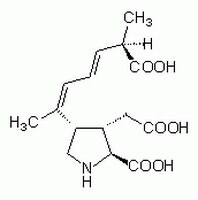324378 Sigma-AldrichDomoic Acid, Mytilus edulis - CAS 14277-97-5 - Calbiochem
Synonyme: 25-[2α, 3β, 4β (1Z, 3E, 5R)]-2-Carboxy-4-(5-carboxy-1-methyl-1,3-hexadienyl)-3-pyrrolidineacetic Acid
Empfohlene Produkte
Übersicht
| Replacement Information |
|---|
Key Spec Table
| CAS # | Empirical Formula |
|---|---|
| 14277-97-5 | C₁₅H₂₁NO₆ |
| Product Information | |
|---|---|
| CAS number | 14277-97-5 |
| ATP Competitive | N |
| Form | White to off-white crystaline solid |
| Hill Formula | C₁₅H₂₁NO₆ |
| Chemical formula | C₁₅H₂₁NO₆ |
| Reversible | N |
| Structure formula Image | |
| Quality Level | MQ100 |
| Applications |
|---|
| Biological Information | |
|---|---|
| Primary Target | Glutamate kainate receptor |
| Purity | ≥95% by HPLC |
| Physicochemical Information | |
|---|---|
| Cell permeable | N |
| Dimensions |
|---|
| Materials Information |
|---|
| Toxicological Information |
|---|
| Safety Information according to GHS | |
|---|---|
| RTECS | UX9665100 |
| Safety Information | |
|---|---|
| R Phrase | R: 20/21/22 Harmful by inhalation, in contact with skin and if swallowed. |
| S Phrase | S: 36 Wear suitable protective clothing. |
| Product Usage Statements |
|---|
| Packaging Information |
|---|
| Transport Information |
|---|
| Supplemental Information |
|---|
| Specifications |
|---|
| Global Trade Item Number | |
|---|---|
| Bestellnummer | GTIN |
| 324378 | 0 |
Documentation
Domoic Acid, Mytilus edulis - CAS 14277-97-5 - Calbiochem Analysenzertifikate
| Titel | Chargennummer |
|---|---|
| 324378 |
Literatur
| Übersicht |
|---|
| Alfonso, M., et al. 1994. Neurochem. Int. 24, 267. Nijjar, M.S., and Grimmelt, B. 1994. Mol. Cell. Biochem. 136, 105. Hampson, D.R., et al. 1992. Eur. J. Pharmacol. 218, 1. Usherwood, P.N., and Barnard, E.A. 1992. Comp. Biochem. Physiol. [C] 103, 19. Tasker, R.A.R., et al. 1991. Can. J. Physiol. Pharmacol. 69, 127. Stewart, G.R., et al. 1990. Exp. Neurol. 110, 127. Bird, C.J., and Wright, J.L.C. 1989. World Aquacult. 20, 40. Wright, P., et al. 1989. Can. J. Chem. 67, 481. |
Broschüre
| Titel |
|---|
| Excitotoxic Glutamate Analogs Technical Bulletin |
| Pathways and Biomarkers of Glutamatergic Synapse Flyer |







